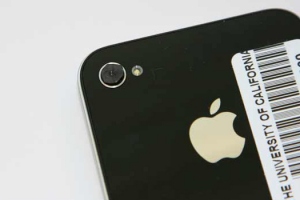The stories that linger around the usage of the iPhone and the other Android devices for medical purposes is not something new these days. However, it is interesting to note the wide range of applications that can be cooked up by means of such applications within a short time frame. It is not just the technology that is involved, but the applications that evolve out of these technologies that make up the real deal of the scenario. Using the mobile phone as a light-weight electrocardiogram or as a skin analysis device to check incept of skin cancer are truly amazing and make anyone marvel at the application.
The iPhone camera has been tweaked to deliver an expanse of applications that cater to industries of different sorts. Be it wide-angle lenses, photographs, or even a zoom of up to 12x, the iPhone has a lot more to offer. However, a group of researchers at the UC Davis Centre for Biophotonics have transformed the lens of the iPhone into a microscope that delivers a magnification of up to 350x. All this happens at a very low amount of $50 or so. Now, be it sending instagrams, or checking a pathological sample, or even analyzing an analyte can be done with ease. Nevertheless, this camera-based iphone device can act as a microscope, a spectrometer, fluorescent spectrometer, and more.
However, it can never be plainly clad as what the iPhone can actually perform. It is the proof of the concept that actually withholds various ideas as such for a variety of reasons. Besides the advantages of being a mere microscope, the iPhone camera can serve other purposes too. This can be taken as a fine example of a lead where higher applications can be sought at.
Nevertheless, the idea of a camera based iPhone is a little spell that is openly visible. Researchers have taken the advantage of a small lens, say 1mm ball lens, and patch it up with the exterior of the iPhone lens by means of a certain type of gluing substance. The big hack lies in exploiting the CMOS technology and the basic microscopic optics to function as a complete microscope as well as a spectrometer.
Technically, the lens offers a magnification of up to 5x. Optically, it is the zoom and the focus that play the greater pitch. The focus is delivered extremely intricate such that the details boil down to a range of about 1.5 microns and bring out the visibility from within. Unlike the conventional microscopes, the view obtained is actually very small, but a powerful combination of in-focus areas and combining several compound pictures, a clear image can be obtained.
In essence, it might seem a phase more than a mere tricorder cam. The multipurpose CPU, the varied inputs for video, and the all new unit that is exclusive for imaging, make the smartphone an ideal device for medical usage. It is definitely not a handy clinic, but in places where electricity and money are a constraint, the iPhone can serve as a tool for easy diagnoses. Invariably, expanding the surge for constant innovation by means of cheap alternatives can definitely lead to improvements in quality health care.
About the author: Kate is an avid writer and blogger. She loves writing on luxury and technology. Beside this she is fond of cell phones. In her free time she loves playing game on her phone. Whereas these days she is busy in researching about Notebook Computers for her new article.



